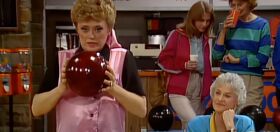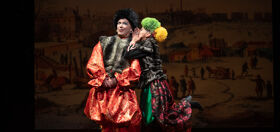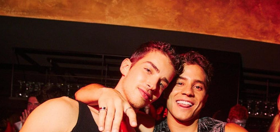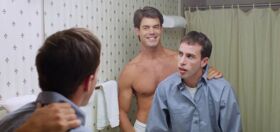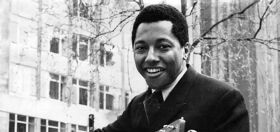
For this installment of The Power Issue, we’d like to introduce you to Joy Silver. She’s the president of a place called Rainbow Vision: a Santa Fe community for older queers.
Basically, the Vision provides about ninety people – many of whom have never lived in queer friendly space – the opportunity to lives out “their last 50 years” in a safe, vibrant and stimulating enviornment.
To be honest, we actually never intended on posting this entire interview. You see, we originally interviewed Silver for an upcoming piece on queer space and power. As we chatted with Silver, however, it dawned on us that she’s the kind of lady who deserves an entire feature. She’s like the queer activist grandmother we never had: imparting her wisdom and experience with equal dashes of insight and thoughtful meanderings.
Thus, we wanted to share the entire conversation. You know, to give a shout out to a lady that we think is pretty fucking cool.
How about we take this to the next level?
Our newsletter is like a refreshing cocktail (or mocktail) of LGBTQ+ entertainment and pop culture, served up with a side of eye-candy.
After the jump, read what Silver has to say about why we need places like Rainbow Vision, why there needs to be intergenerational communication and what we can learn from Alexander the Great. And it doesn’t involve dogs…
Joy Silver: Hi, what can I do for you?
Queerty: We’re putting together a piece on space and power. We wanted to talk about Rainbow Vision and the empowering aspects of a queer friendly retirement community.
JS: Oh. All right.
QT: What was the main impetus behind founding Rainbow Vision?
JS: The main thing about putting a community like Rainbow Vision together is to give us, the minority people, a chance to be in the majority. And not only to be welcomed, but to be able to find each other in the second part of our lives or after the age of 60. It’s very important that community is established, because many times this is our family of choice – our friends become our family of choice. To be among our cultural values – it’s almost parallel to ethnicity and culture – to create something like that, I think, it was just waiting to happen. All I did was be part of that.
QT: How many people live there?
JS: About 90 people right now.
QT: How many of them are gay or transgendered…
JS: I’d say about 80%
QT: It must be really nice for them, growing up in a time when homosexuality and queerness in general wasn’t accepted, to come together and live. We saw in the paper the other day that you guys were having a Halloween party?
JS: Yes we did! We certainly did. It was amazing – everybody got dressed up – you know, Halloween’s a very important holiday for LGBT people. To celebrate our own holiday the way we like is just amazing.
QT: Do you have any involvement with any other gay organizations in Santa Fe?
JS: All of them. We’re involved with all gay organizations here. You know, the interesting thing is that there are those people who didn’t grow up in a time when being LGBT was understood or accepted, but there are also people here who have lived in settings that are very gay friendly…
QT: Do you go out of your way to bridge the intergenerational divide with younger queers?
JS: We have events here that bring people of all ages together to enjoy the events within the community. So, yes, we’re very much part of that.
QT: That’s refreshing, because some people may say that by forming this community you’re taking away something from younger queers.
JS: Well, do you think that mainstream communities are taking away things from the younger population?
QT: It’s not as important because of the struggles queer people have to go through. Older queers who lived through the first generation of the revolution or lived most of their lives in the closet have a lot to teach younger people who are coming out of the closet, whom are facing [animosity] in mainstream society.
JS: I think you’re right about that. That’s why we have education on gay history here where the community is invited. We also have different members of the community with different skills – one of our outside people is coming in and she’s talking about her mother, who was a photographer. It’s a very integrated thing here in terms of generations.
The thing is that Rainbow Vision is known to be the place where you can find these kinds of events. It’s become very important to the community in that way. Most of the events in the most of the place where gay people find each other are in bars and discos. When you get to a certain age, it’s like ‘Been there, done that’, so to have a center where there are activities for all gay people, it sort of becomes the gay community center.
QT: Do you have any body that comes to live there who hasn’t been out or who has just come out?
JS: Yes. We have people who have moved in from different places who haven’t lived in gay places or who haven’t been out and they feel like they’re in heaven! You know, we have people here – remember, it’s not just who’ve retired, we have people who just want to live in a gay environment. It’s an amazing thing to hear from people who have never been out in their entire lives and come to a community like this and just say to me, “I’m just in heaven”.
QT: And what other work did you do before this?
JS: I sat on the sub-committee for senior housing for SAGE in New York. I learned a lot about what was happening to our community. I’m also on the board in San Francisco for the LBGT historical society. So, I’m very aware of our population, our people and our history. I think that if you don’t know your history and you don’t know where you’ve been, you certainly don’t know where you’re going.
QT: How do you feel about the younger generation of gay people out there?
JS: I’ve had a lot of opportunity to talk to the younger gay people and I think that when I do talk to them, I [notice] two things: they are extremely interested in history – and that always surprises the older gay people – [and], they don’t have a lot of knowledge about their history, so they really want to know, and I think that’s a great thing.
QT: Who’s your favorite historical gay figure?
JS: Well, that’s interesting…I’m kind of interested in and taken with Alexander The Great. Here’s a guy with a vision – he was a “conqueror”, but he was really bringing culture and integrating the world into a single world. I thought, “This is interesting: a gay man doing this”. If you told him “no”, then he was going to show you how it could be done, and I think that’s very inspirational for gay people.
I think we continue to do that, in his legacy. We want to make things beautiful. I think we’re a creative people. I think that we’re a diverse people and that I think really makes life wonderful.
QT: Do you think that there are any concessions that need to be made on the gay side to integrate into mainstream culture?
JS: I would like to see mainstream culture integrate more into our culture.
QT: How do you think that can be done?
JS: Well, I think that we need our rights. I think that we’re contributing, creative people and it’s just amazing to me that we don’t have full rights as citizens in the United States. That would be a really good way for them to integrate into our culture.
QT: Is there is anything else that you would like to say?
JS: I just want to restate that it’s really important to know from where we came to know where we’re going. That’s powerful.




